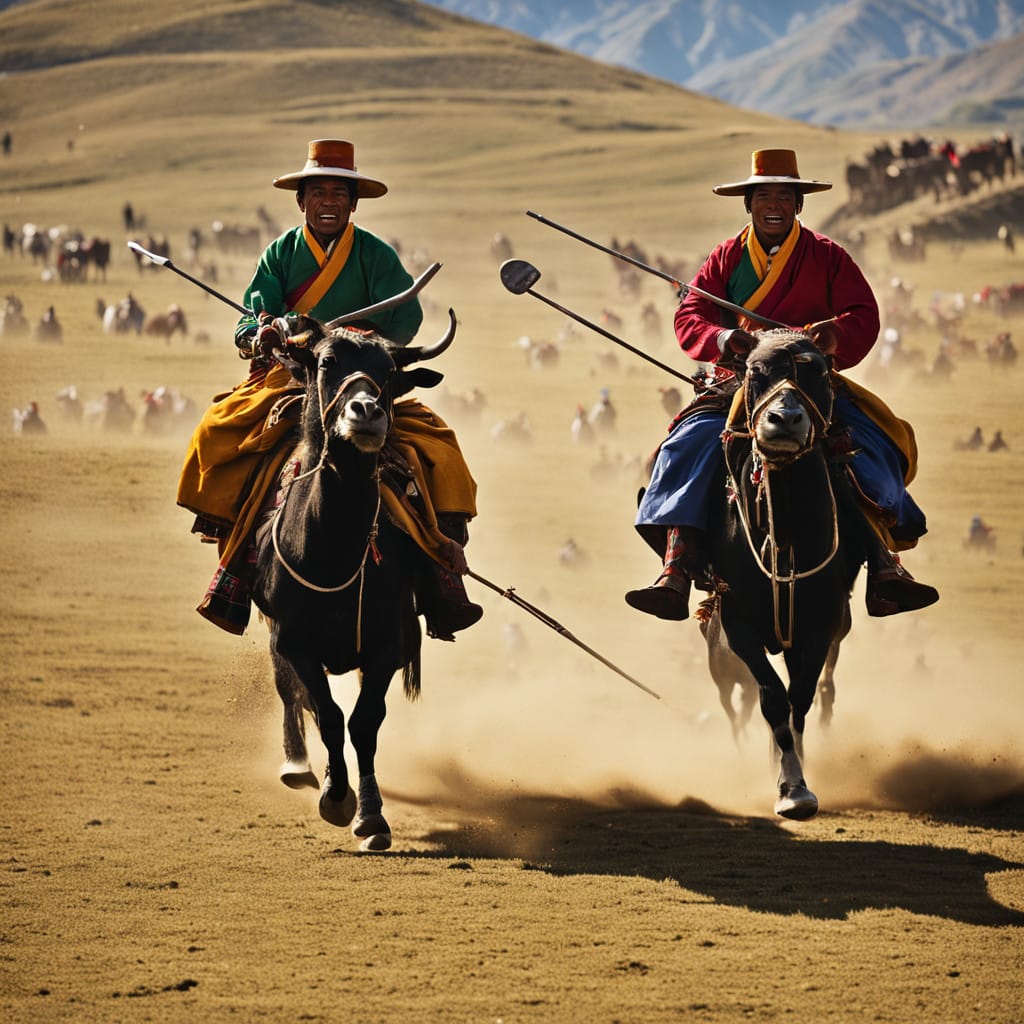
The Thrilling World of Yak Polo: A Unique and Captivating Sport
Yak Polo is a sport that captures the imagination with its blend of tradition, adventure, and sheer uniqueness. Rooted in the rugged landscapes of Central Asia, this extraordinary sport combines the exhilaration of horseback polo with the cultural significance of yaks. While it may not yet have the global recognition of its equestrian counterpart, it has steadily gained popularity. This blog explores its fascinating history, global appeal, amateur and professional participation, cultural significance, and the rules that govern this extraordinary game.
The Origins and History of Yak Polo
The story of Yak Polo begins in the high-altitude regions of Central Asia. The sport is believed to have originated in Mongolia, a country with a deep connection to yaks as both livestock and cultural symbols. Some historians argue that it was invented as a practical alternative to traditional horseback polo. In the challenging terrain of Mongolia, yaks provided a more reliable mode of transport, making them a logical choice for this adaptation of polo.
The roots of Yak Polo can also be traced to the nomadic lifestyle of the region’s inhabitants. Nomads often relied on yaks for food, clothing, and transportation. Over time, they began using yaks for leisure and competitive activities, leading to the birth of Yak Polo. By the mid-20th century, the game was being played informally in various Mongolian communities. However, it wasn’t until the late 20th century that efforts were made to formalize its rules and promote it as a recognized sport.
The introduction of organized Yak Polo is largely credited to tourism initiatives in Mongolia and neighboring countries. These efforts aimed to showcase the region’s unique culture and attract international visitors. In recent decades, the game has spread beyond its traditional heartlands, finding enthusiasts in countries such as Bhutan, Nepal, and even the United States.
The Global Popularity of Yak Polo
Although it is still relatively niche, it has seen significant growth in popularity. Its appeal lies in its exotic nature, cultural richness, and the sheer novelty of playing polo on yaks. Several countries have embraced the sport, both as a tourist attraction and as a way to celebrate Central Asian heritage.
In Mongolia, Yak Polo remains a cherished tradition. Annual tournaments are held in regions like Khovsgol, attracting both locals and tourists. These events often coincide with cultural festivals, featuring traditional music, dance, and cuisine. Bhutan and Nepal have also embraced the sport, integrating it into local celebrations and tourism packages.
In recent years, it has made inroads into Western countries. Adventure enthusiasts and cultural organizations have organized exhibitions and friendly matches in the United States and Europe. While these events are often recreational, they play a crucial role in introducing the sport to new audiences. Social media has further amplified its reach, with videos and photos of Yak Polo matches capturing the imagination of viewers worldwide.
How Amateur Yak Polo Is Played
Amateur Yak Polo serves as the foundation for the sport’s growth and accessibility. Many communities in Mongolia, Bhutan, and Nepal organize informal matches for recreation and cultural preservation. These games are often less competitive and focus on fostering community spirit.
Youth participation is particularly important. In schools and youth clubs, children are taught the basics of Yak Polo. These programs emphasize safety, teamwork, and cultural appreciation. By engaging young players, organizers ensure the sport’s continuity and relevance.
Community tournaments are another common feature of amateur Yak Polo. These events bring together players of all ages, creating a festive atmosphere. Spectators cheer for their favorite teams, and participants take pride in representing their villages or families. Such gatherings also serve as an opportunity to pass down traditional skills and knowledge related to yak handling.
In addition to traditional settings, some adventure tourism companies offer amateur Yak Polo experiences. Tourists can try their hand at the sport under the guidance of experienced players. These sessions are tailored for beginners, ensuring a fun and safe introduction to Yak Polo.
Professional Leagues and Competitions
Professional Yak Polo is still in its nascent stages, but it is steadily gaining momentum. In Mongolia, the sport’s unofficial capital, several leagues have been established. These leagues aim to professionalize the game by standardizing rules, training players, and organizing regular tournaments.
The Mongolian Yak Polo Association plays a pivotal role in promoting the sport. It oversees league matches, recruits players, and collaborates with international organizations to increase visibility. Some tournaments offer cash prizes and sponsorship opportunities, providing incentives for players to pursue Yak Polo professionally.
Bhutan and Nepal have also established their own professional leagues. These competitions often feature teams from neighboring countries, fostering regional camaraderie. In recent years, international Yak Polo tournaments have been organized, bringing together players from Asia, Europe, and the Americas. Such events showcase the sport’s potential to unite diverse cultures.
Despite its relatively small scale, professional Yak Polo has already produced several notable players. These athletes serve as ambassadors for the sport, inspiring younger generations to take it up. Media coverage and sponsorship deals are gradually increasing, paving the way for further growth.
The Political and Social Significance of Yak Polo
Yak Polo is more than just a sport; it is a cultural phenomenon with deep political and social implications. In Mongolia, it serves as a symbol of national pride and heritage. By promoting Yak Polo, the country asserts its unique identity on the global stage. The sport also reinforces the importance of preserving traditional practices in the face of modernization.
In Bhutan and Nepal, it plays a similar role. It highlights the region’s cultural diversity and promotes sustainable tourism. Many communities use the sport to showcase their way of life to visitors, fostering cross-cultural understanding. The economic benefits of Yak Polo tournaments, including increased tourism and local business opportunities, cannot be overstated.
On a broader scale, Yak Polo has the potential to build bridges between nations. International tournaments bring together players and spectators from different countries, creating opportunities for dialogue and collaboration. The sport’s emphasis on teamwork and mutual respect resonates with audiences, making it a powerful tool for cultural diplomacy.
Socially, it fosters a sense of community and belonging. Local matches and festivals bring people together, strengthening social bonds. The sport also provides a platform for celebrating the contributions of yaks to the region’s way of life. By participating in Yak Polo, individuals reaffirm their connection to their cultural roots.
The Rules of Yak Polo
Yak Polo follows a set of rules that ensure fairness, safety, and enjoyment. While variations exist between regions, the core principles remain consistent. Here is an overview of the key rules:
- Team Composition: Each team typically consists of four to six players. The number may vary depending on the size of the playing field.
- Playing Field: Matches are played on open fields or flat terrains, often in mountainous regions. The field’s dimensions are smaller than those used in traditional polo.
- Equipment: Players use mallets made of wood or bamboo. The ball is usually made of rubber or leather, ensuring durability.
- Duration: Matches are divided into two halves, each lasting 15 to 20 minutes. A brief interval allows players and yaks to rest.
- Scoring: Goals are scored by hitting the ball into the opposing team’s goalposts. The team with the most goals at the end of the match wins.
- Yak Handling: Players must demonstrate proper yak-handling skills. Cruelty or negligence toward the animals is strictly prohibited and can result in penalties.
- Safety Measures: Protective gear, such as helmets and pads, is mandatory for players. Yaks are also equipped with comfortable saddles and harnesses to prevent injuries.
- Refereeing: Matches are officiated by referees who ensure compliance with the rules. Fouls, such as dangerous play or unsportsmanlike conduct, are penalized.
These rules strike a balance between preserving tradition and ensuring the sport’s safety and accessibility. As it continues to evolve, efforts are being made to standardize its regulations further.
Conclusion
It is a sport like no other, blending cultural heritage, athleticism, and the spirit of adventure. Its rich history, growing global appeal, and social significance make it a truly captivating pursuit. From amateur matches in remote villages to professional leagues and international tournaments, Yak Polo offers something for everyone. By celebrating this extraordinary sport, we honor the traditions of Central Asia and create new opportunities for cultural exchange.
As it continues to gain recognition, its potential to inspire and unite people becomes increasingly evident. Whether you’re a seasoned athlete, a curious tourist, or a cultural enthusiast, this unique sport invites you to experience the thrill of the game and the beauty of its traditions. Embrace Yak Polo and join the journey into one of the world’s most fascinating sports.





